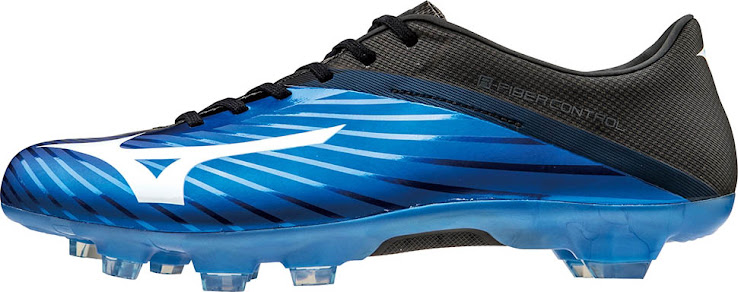Next-Gen Mizuno Basara 2015-2016 Boots Released
The next-generation Mizuno Basara 2016 Football Boots introduce a brand-new design for Mizuno's Speed Boot while maintaining the key technologies of the first generation. Officially released in early October 2015, Shinji Okazaki headlines the new Mizuno Basara 101 Soccer Cleats.
In May 2014, the Japanese brand Mizuno released their first-ever high-end football boot with a synthetic upper. Made for ultimate speed, the Mizuno Basara 001 Football Boot was launched with a striking yellow colorway and debuted in the 2014 World Cup in Brazil.
Mizuno Basara 101 Blue / Black / White
This is the second generation of the new Mizuno Basara Soccer Boot.
Similar to the first generation of the Mizuno Basara, the second-generation of the Mizuno Basara Football Boots feature the ultra-thin and flexible Primeskin material in the touch area. The DynaMotion Fit technology is made to mirror the natural movement of the foot.
While Primeskin and DynaMotion fit are all about a second-skin fit, Mizuno did not forgot that football players need lockdown and stability for ultimate speed. Therefore, the next-generation Mizuno Basara 101 Boots feature Mizuno's patented R-Fiber Control technology for more stability in the areas where it's needed most: the heel and midfoot.
But the most remarkable element of the new Mizuno Basara 101 Cleats is the synthetic leather-like material on the instep. Directly connected to the tongue of the boot, the synthetic leather is made for more accurate passes and increased swerve in all weather conditions.
While Mizuno introduces various new technologies for the upper of the Basara, the Pebax sole plate of the Mizuno Basara 101 Cleats remains unchanged. Featuring just two studs in the heel area and seven triangular studs in the forefoot area, the stud alignment is made for instant acceleration on Firm Ground surfaces.
The new Mizuno Basara 101 2016 Boots combine the colors blue, black and white to create a classy look for the utterly important launch colorway. While the Primeskin touch area of the Mizuno Basara 101 Boots is blue, the heel area of the Mizuno Basara 101 Cleats is black, creating a half-and-half design.
A unique shimmering lines graphic pattern on the upper gives the Mizuno Basara 101 Boot a sense of speed, whereas the white number 101 is printed on the instep with a racing-inspired LED style numbering. The design of the next-gen Mizuno Basara Boot is all about forward motion and speed.
In summary, it can be said that Mizuno did not dramatically changed their product but only made slight changes for the next-gen Mizuno Basara, which weights in at 190 gram and retails at the same price as the first generation (140 GBP, 180 Euro, 210 USD). But Mizuno did not only release a synthetic version of for the second generation of their speed boot, the Japanese brand also introduces an all-new Basara Japan edition with a Kangaroo leather upper.
Mizuno Basara 101 Japan K-Leather Blue / Black / White
This is the K-leather edition of the Mizuno Basara 101 Boots.
The Mizuno Basara 101 Japan Edition features a super soft Kangaroo leather in the forefoot area with traditional stitching, whereas the heel area uses a synthetic like leather material for lower weight and water uptake while providing comfort and stability. As it's the case with all leather boots, the soft Kangaroo leather in the touch area is made for increased ball control in any weather conditions.
Apart from the K-Leather upper, the design and the technologies used for the Mizuno Basara Kangaroo Leather Cleat are the same used for the synthetic version. It's only logical that the Mizuno Basara Leather Boot is heavier than the synthetic release, weighing in at 220 gram.
But why is the Mizuno Basara Kangaroo Leather Boot called Japan edition? That's quite logical. Whereas the synthetic version of the Mizuno Basara Boot is produced in low-income countries in Asia, the leather edition of the Mizuno Basara Boot is handcrafted in Japan. Nevertheless, the Mizuno Basara Kangaroo Leather Boot is only slightly more expensive than the synthetic version (approximately 160 GBP, 200 Euro, 240 USD).
Shinji Okazaki already debuted the brand-new synthetic version of the Mizuno Basara 101 Boots in Japan's 2018 FIFA World Cup Asian Group E qualifying match against Syria.
Various changes, but not revolution. What's your first verdict on synthetic and leather versions of the next-gen Mizuno Basara 2016 Football Boots? Let us know in the comments section below.


















